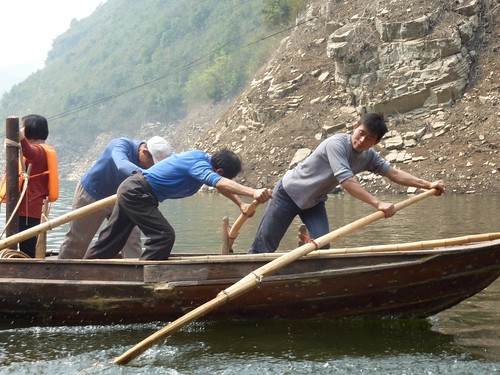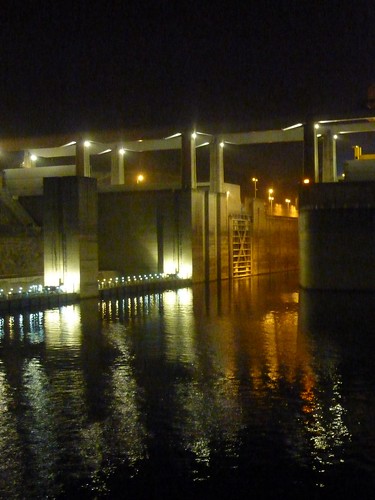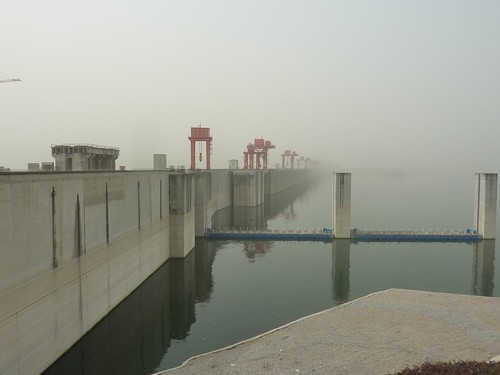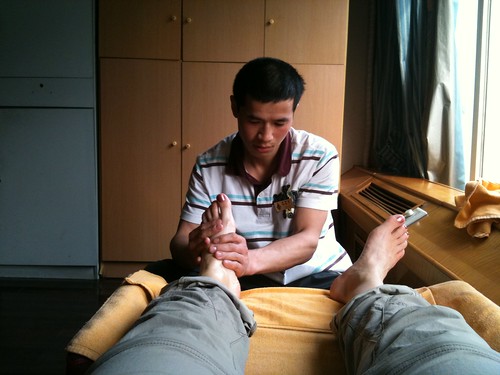The second morning on the boat was relatively calm. I had my tea and peanut butter in my cabin and wandered up to the sundeck to see us pass through the second of the Three Gorges – Wu Gorge. I declined to get up in time to see us pass through the first – Qutang Gorge, reasoning that one gorge must look a lot like the other, and there was no need to wake up at 6:00 am for Qutang when we’d be passing through another perfectly serviceable gorge at 9:00 am. It was only later that I bothered to consult the LP and found out that Qutang Gorge is quite different than Wu Gorge, and is figured by some to be the most awe-inspiring of the three. Well, you win some and you lose some, and I still got my peanut butter.
It was a misty morning, so my photos of Wu Gorge all have a kind of dreamy quality. It was pleasant; I spent most of the morning chatting with Randy and some other GAPpers, taking photos and trying to make sense of the charming but broken English of Eric, our River Guide. There were two guides on the boat – one was Eric, a very young and exceedingly shy Chinese guy who was on his first trip as a guide. The second was a Chinese man who was there to translate for and guide a group of German tourists on the boat. Eric’s English was ok, but halting, and his vocabulary and sentence construction left something to be desired. As a result we spent a lot of time listening to the remarkably fluent German guy drone on and on, often for ten to fifteen minutes at a stretch. Then he’d pass the microphone to Eric, who would explain the same site something like this: “On our left hand is the Swallow Cave. Is cave very long and is called Swallow Cave. Local people call is Swallow Cave because swallows who living there.” End of comment. I think the Germans were really getting their Deutschmark's worth out of their guy, but I wouldn’t have traded Eric for anything. He was a delight.
The gorge itself was scenic, but I couldn’t help but feel I’d arrived a few years too late. Since the Three Gorges Dam project was completed the water level upstream in the gorges has risen about 50 metres. They were still undoubtedly lovely, but when they were more than a hundred and fifty feet deeper it must have been breathtaking.
That afternoon we had another excursion off the boat, this time to view one of the tributaries of the Yangzi, Shennong Stream. We got off the trusty MS Fortune and onto a ferry for about an hour, then got off the ferry and onto some very small riverboats, rowed by local boatmen. The boat themselves were nice enough, but there were so many tourists that getting off the large ferry and onto the small boats was a bit of a madhouse.
They boats were a traditional style for the area, called pipa, used by the Tujia people for generations – long predating the dam and the rising waters. The Tujia are one of China’s minority ethnic groups (all of which, when taken together, make up just 8% of the population). There are only a few million Tujia, but apparently they even have their own written language. When the water level on Shennong stream was lower the local Tujia boatmen used to row downstream, but had to haul the boats upstream. They’d strip naked and walk through the fast, shallow water pulling the boats with stiff rope made out of bamboo. They demonstrated this for us briefly, though there was no getting naked, and we were going downstream not up, and they had to pull along a specially constructed towpath at the side of the water, so really it wasn’t much like the real thing at all. They were hard workers, though. You could really see them putting their backs into it as they rowed.
 The Tujia boatmen, hard at work
The Tujia boatmen, hard at work
It was around this time that I started to feel more of that affluent western guilt that I mentioned back on the Ganges river trip in India. These boatmen were working hard, and some of them were not young men. There were certainly some over sixty, and there wasn’t an ounce of fat on any of them. They don’t have an easy life. Most were local farmers who row for tourists to make extra money. Many of the older people never went to school, and the houses in the area only got electricity in 1990. Then here was I, benefitting from their sweat and toil, and the biggest decision I had to make that afternoon was whether I’d have a nap right when we got back to the boat and then go for my 90 minute foot and body massage, or go to the massage first and then nap.
In the end I went for the massage, and it was quite nice. But there was more of the Western guilt involved, especially when I found myself reclining on a couch with a guy washing my feet and a young waitress in a uniform serving me cold beer on a tray. Luckily, I got over it. The massage was good – the guy worked on my feet for about 45 minutes, and then my back, legs and shoulders for at least that long again. I left feeling a little beat up because though he was small, he was extremely strong. I definitely needed that nap.
That evening we enjoyed the Captain’s Farewell Banquet (though I think it was noted on the day’s schedule as the “Well Fare Banquet”). It was a fairly standard Chinese meal, and because there were mostly Chinese tourists on the boat, some stranger dishes showed up than we’d seen before. When we eat in restaurants as a group Huang usually orders for us, so he tends to stay away from the really weird stuff. On the boat, there was no filter between us and the kitchen. As a result, a few odd things showed up on the table. There was the pie plate of a soupy sort of chicken flavoured pudding. And there was the plate of banana chunks and chopped hard-boiled egg whites. But I was particularly taken with one dish, not for its flavour, but because it reminded me of a saying:
Intelligence is knowing that tomato is a fruit. Wisdom is not putting it in a fruit salad.
Apparently this is not common wisdom in China, because a couple of times we were served a salad of banana and melon with a sweet creamy dressing… and halved cherry tomatoes. Like I said before, it’s kinda ALL weird food.
The big event on that last evening was our arrival at the Three Gorges Dam. We were scheduled to pass through the five-stage locks starting at around 8:30 pm. I was quite excited about this, because I’m a bit of a geek for engineering mega-projects, and they don’t get much more mega than the Three Gorges Dam. I was a bit disappointed that we’d be passing through the locks in the dark, but it turned out to be kind of neat.
 Waiting in the queue for the locks. We couldn’t enter until there were enough ships to fill up the whole lock.
Waiting in the queue for the locks. We couldn’t enter until there were enough ships to fill up the whole lock.
I spent most of the time while we waited chatting with Randy, because if there’s one thing that big ships and big locks and big things in general are NOT, it’s fast. Eventually they opened the gates and each ship slowly jostled into position in the lock. It was a tight fit for some, and the side walls of the lock were scored by the sides of many ships that came before us. I kept picturing some poor guy in the maintenance department sighing and pulling down a can of paint and a brush. Again.
 Me and Randy, waiting for the locks
Me and Randy, waiting for the locks
After my grueling day of being rowed around, massaged and generally pampered, I was pretty knackered and didn’t end up having the energy to wait until the lock was full and we started to descend. I figured that the idea was probably more interesting than the actual event, which would probably be mostly imperceptible. Instead I went to bed for my last night in cozy cabin 217.
Our last morning on the boat was taken up with an excursion to the dam itself. I’d been really looking forward to this, but it ended up being a bit of a disappointment. It was another foggy morning, but while that had simply added to the atmosphere when passing through the gorges, on Dam Day, it just made it hard to see much of anything. And once again there were throngs of tourists and long lines, and pushing, shoving crowds. I kind of reached my breaking point with it all at some point that morning, as, I think, did the rest of the group. I suspect I was the only Dam Fan in the group to begin with, so most of them were only there because it was on the agenda. And if I was disenchanted with the whole business, I can only imagine what they must have been thinking.
 My best, misty shot of the Three Gorges Dam.
My best, misty shot of the Three Gorges Dam.
However, my disenchantment with the day will not spare you from a torrent of random Three Gorges Dam facts that I picked up from various guides and guidebooks. Though the LP claims that the 3G is the largest dam in the world, Huang says there’s one in the States that’s bigger. At 2.3 km long and 80 m wide, it’s China’s biggest engineering project since the Great Wall and is estimated to have cost up to 75 billion USD. (The local guide said 27 billion, but in this case I think I’ll go with the LP). The construction started in 1992 and was completed in 2009. The only part still under construction is the ship lift, which, when completed in 2014 will allow a ship to pass from above the dam to below it in about 40 minutes, instead of the three to five hours it takes to pass through the five locks. I suppose this is the Three Gorges equivalent to the Falkirk Wheel (Remember that? It was 372 years ago!)
The damn was primarily built to control flooding on the river, but the turbines in the centre of the dam now produce power equivalent to that of 18 nuclear power plants. And while the flooding upstream of the dam has made the Yangzi navigable for large container ships as far as Chongqing, it’s estimated to have displaced somewhere between 1.2 and 1.5 million people, all of whom had to be relocated. It’s also thought that about 8,000 archeological sites were lost, 10% of which might have been saved. Most alarming, the LP reports that about a hundred cracks were found in the dam in 1999, and though Chinese engineers claim that these occurrences are common in large dams and have been fixed, there’s still doubt about the integrity of the structure, especially since the earthquake in Sichuan in 2008.
All of this makes me glad I saw the dam, but also glad that I’m now on the third of four overnight trains of the trip, speeding away from Yichang, a city that would be inundated within an hour if the dam were to fail. This time we’re treated to a Soft Sleeper, which has the advantage of having only four beds per compartment, but whose mattresses struggle to deserve their “soft” label. After a mere 15 hours on the train, and another three and a half on the bus, we’ll end up in Yangshuo where there will be lots of fun activities to participate in and blog about, so don’t touch that dial.
Another bonus Chinglish Picture. They’re just so good I have to share. This one is from the bathrooms at the parking lot at Emei Shan, placed just below an open window.:







2 Comments:
Awesome shot of the Wu gorge, Pam. Also lovin' the Chinglish signs.
My dad was a hydro dam engineer, so I share your excitement in seeing such a large example.
Love them big-ass Penstocks!
http://en.wikipedia.org/wiki/Penstock
rh
Post a Comment